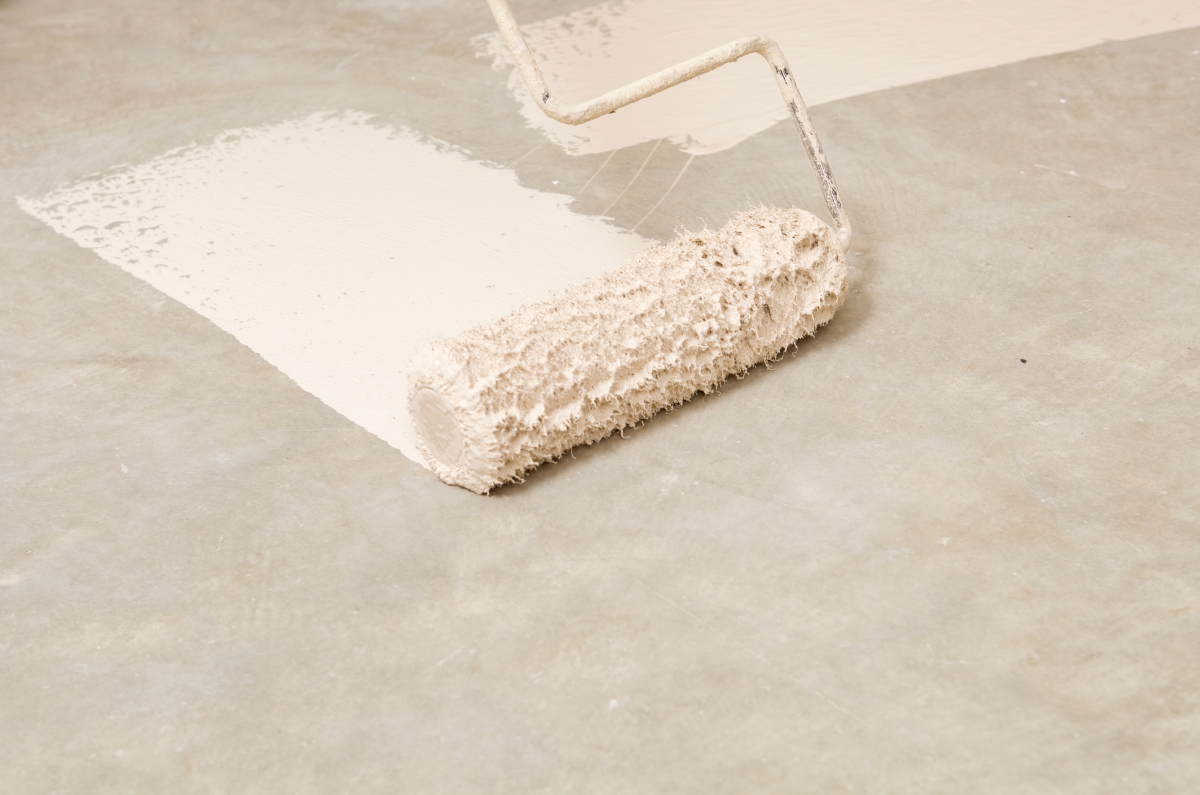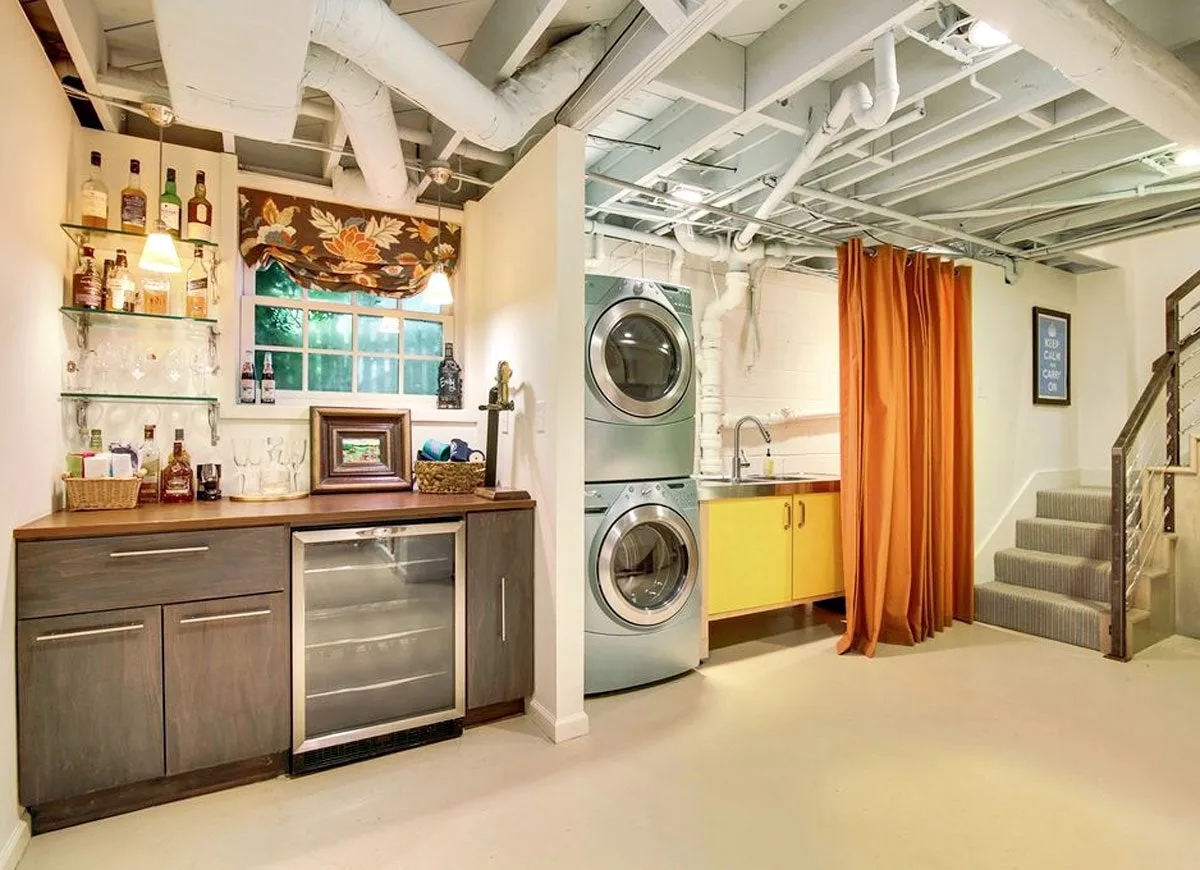We may earn revenue from the products available on this page and participate in affiliate programs. Learn More ›
An unfinished basement is like another world of opportunity lying beneath your feet. While finishing the subterranean space may be the best way to fully optimize and expand livable square footage, it’s not always possible due to budget constraints. There is, however, a variety of easy-ish ways to transform the land down under into a more pleasing and comfortable space that can be used as a bare-bones workout space, teen hangout area, playroom, or hobby zone.
Here are some budget-friendly unfinished basement ideas for DIYers who want to update their basement but don’t want to involve permits or licensed contractors.
Flooring Ideas
Creating a more usable unfinished basement often starts with a flooring update. While installing a new permanent flooring system requires some DIY experience and understanding of underlayment, temporary and movable floor options can increase your comfort without requiring a lot of work.
1. Lay down foam mats.

Most unfinished basements have a poured concrete floor. Soften it up for playtime or workout time with square foam floor mats, like the ProsourceFit Puzzle Mat. Foam floor mats come in different sizes and colors (even in faux-wood finishes!), and join together like a puzzle—and they’re easy to clean, replace, or pick up and move elsewhere. Plus, they stack away and store when your needs change.
Note: Before you lay down any floor covering, do what you need to do to make sure the space is dry and clean. Fix any water issues and add waterproofing if necessary.
2. Roll out some area rugs.

Area rugs can warm up a cold basement floor quickly. As it’s an unfinished space that will likely experience more wear-and-tear than the rooms upstairs, an outdoor rug may be a smart choice for some basements. However, if you want the plush feeling underfoot of an indoor rug, consider choosing a waterproof rug pad, like this one from Lifeproof.
Depending on the size of your space, you might want to choose one large rug for a main area and a few smaller ones to create other activity zones. Another option is a carpet remnant—a low-cost, effective option that can both cozy up a basement and help define different functional areas in the space.
3. Brighten up the floor with paint.

An unfinished basement’s concrete floor is a blank canvas, and a coat of paint can make a huge difference. Follow our guide to how to paint concrete floors, which includes how to prepare the surface so the painted finish will last. This straightforward DIY project can take a good deal of muscle and time, especially if you need to move boxes and other items out of the way. However, paint will give you a big bang for your buck when compared to other ways to freshen up the floor in an unfinished basement.
Lighting Ideas
It can be tough to navigate an unfinished basement that isn’t lit properly, and many unfinished basements don’t have the same access to outlets and wired overhead lighting that the upstairs finished spaces include. Instead of calling the electrician to wire the basement, consider a few DIY ways to add light.
4. Mount overhead lights.

Since unfinished basements aren’t considered habitable rooms under building codes, they have fewer electrical outlets and fixtures mounted in the ceiling. Bring more light to the space and make it easier for you to see when you enter the room with rechargeable motion-sensor ceiling lights. Battery-powered lights that don’t use any wires, like the Toowell ceiling light, can work for 3 months on one charge.
5. Decorate with string lighting.

If you are aiming to create a fun playful ambience in your basement, consider hanging fairy lights or string lights. String lights add ambiance and set a magical mood, and they can be installed in a variety of ways. Hang a series of fairy lights from one wall, string them along a stair railing, run them along the ceiling joists, or line the perimeter of the room. It just requires mounting hooks and some battery-powered fairy lights, like these Twinkle Star waterproof fairy string lights, and some time to create what’s in your imagination. The Twinkle Stars was a noted product our hands-on tested guide to the best string lights.
6. Illuminate the stairs.

Adding stair lighting might be the most important safety update you can make to a basement, as about 1.5 million falls are treated in ERs every year in the U.S., and an average of 1,800 older adults die from falls annually. With motion-sensor battery-operated stair lighting like these dimmable Yunlex lights, everyone in your household can access the basement more safely.
7. Install ambient sconces.

Wall lighting is a favorite addition of many interior designers, as they provide more flattering ambient lighting than any light shining down from above. With battery-operated sconces, it’s possible to add them wherever you desire without the need for a permit or a licensed electrician. The stylish motion-sensor sconces from Montford can also work as handheld flashlights, which might become a convenient way to navigate the house during a power outage, too.
Storage Ideas
An unfinished basement often becomes the default storage area. As boxes and bins pile up, it can be tough to find what you need. Including some shelves, hooks, and other storage solutions can make it easier.
Note: If wet basements are an issue in your neighborhood, make sure you have a sump pump and appropriate waterproofing before storing anything important or valuable in your unfinished basement.
8. Line walls with shelves.

Having an extra floor below grade means you have a lot of potential storage space underfoot. Make the most of your unfinished basement by installing hooks and shelving to store off-season clothing, sporting gear, tools, and more. While you can add shelves to all of the perimeter walls, another option is to build shelves parallel to each other like in a library. This will increase the shelf space and the ability to access both sides of most shelves, too.
If you are looking for new shelving systems, many of the shelves tested for garages in our helpful guide work well for basements, too.
9. Organize with pegboards.

Pegboards are an easy way to sort and organize small tools, wrapping supplies, craft gadgets, and other hobby gear. More than just a method of creating a home for each item, a pegboard can be customized with paint to brighten up the basement, too.
As most basements have some sort of solid block walls, you’ll likely need to drill into concrete to hang a pegboard. If pegboards suit your space, be sure to check our guide to how to install a pegboard, and read about ways homeowners are using pegboards to keep their things tidy and handy.
Wall Ideas
If your basement is mostly underground, there’s likely a lot of wall space staring at you. As it’s a basement, the walls are usually concrete and not the most inspiring hue of gray. If the basement is dry and there’s no chance of moisture seeping through, there are a few DIY options to update the walls and create dividers within the space so your family can enjoy separate activities.
10. Paint the concrete block.

Basement walls are typically made of concrete block, brick, or even poured concrete, and they can be transformed pretty quickly and simply with a coat of paint. Still, painting is not a solution for every basement. Even though there are ‘waterproof’ paints that are designed for basement applications, paint applied to basement walls that have moisture issues will not last for many years, and the paint could make the wet basement situation worse and more expensive to manage later.
Still, painting is one easy DIY way to brighten up a subterranean space that doesn’t need waterproofing. Read our guide on how to paint concrete so you can get started confidently.
11. Create a partition.

If you have DIY experience, consider building a small, temporary wall to divide the space in the basement. Unlike a permanent wall, a partition always doesn’t have to extend from the floor to the ceiling and it can help to delineate space without requiring permits and major planning. Also, depending on how you use the space, there’s no need to drywall or paint the partition. The studs in the partition can be quickly covered in plywood.
You can also combine a small partition wall with a curtain divider to create a little work space like a laundry area that can be closed off visually from the rest of the basement. Our guide to room divider ideas has even more clever ways to partition your space, some of which you can make yourself.
12. Create rooms with curtains.

If you’d like to create rooms within an unfinished basement and you don’t have the know-how and budget to construct partitions from studs, consider a simple and inexpensive curtain system or folding screens to divide space and add dimension. To hang curtains, install a track along a ceiling joist or attach curtain hooks with clips on the ceiling joists. Then, sew-in washers or other weighted objects along the hems of the curtains. The weights will keep the curtains from moving when the HVAC system turns on and off, or as air flows through open basement windows.
Ceiling Ideas
The ceiling might not be the first area many homeowners consider as they mull an unfinished basement update. However, it’s as essential as the floors and walls: Sound easily transfers to the basement from the finished spaces upstairs; a ceiling upgrade that quiets footsteps and appliance noise is often a top priority on a homeowner’s basement to-do list.
13. Insulate the ceiling.

By adding insulation between the ceiling joists, you can decrease the sound transfer and increase the thermal efficiency of the entire house. According to the EPA, homeowners can save about 15 percent on heating and cooling expenses after they seal their homes and add insulation in basements and attics.
14. Paint the joists.

Painting the exposed joists and the underside of the flooring underlayment in your basement ceiling can make the entire space feel more finished without heavy renovation. While you might want to choose a dark hue like matte black to create a modern vibe, creamy white could help to make the space feel fresher and more open. What’s more, all of your utilities will remain completely accessible, in case you need to make repairs in the future.

